Effect of wetting-Drying cycles on surface cracking and swell-shrink behavior of expansive soil modified with ionic soil stabilizer
This paper presents the results of an experimental investigation of the
effect of wetting-drying cycles on the surface cracking and swell-shrink
behavior of modified expansive soils. An image processing technique was
employed to understand this effect by quantifying the surface crack area
density, crack number, crack length, mean crack width, and absolute
shrinkage. Parameters such as height, the relative rate of expansion, and
linear shrinkage were used to characterize the effect of wetting-drying
cycles on the swell-shrink behavior of the specimens subjected to various
overburden pressures. The results showed that the increase in the number
of wetting/drying cycles accelerated the crack growth and led to the
increased crack number, total crack length, and surface crack area
density. Moreover, as the number of wetting/drying cycles increased, the
absolute shrinkage to be on the rise, and the mean crack width exhibited
fluctuation characteristics. Furthermore, the moisture content was
inversely related to the crack extent. For the specimens subjected to
various overburden pressures, the height and the moisture content
showed a good linear relationship. With the increase in wetting/drying
cycles, the relative rate of expansion of the specimen decreased.
Additionally, a larger overburden pressure resulted in a lower relative
rate of expansion; however, as the number of wetting/drying cycles
increased, the relative rate of linear shrinkage increased and then decreased
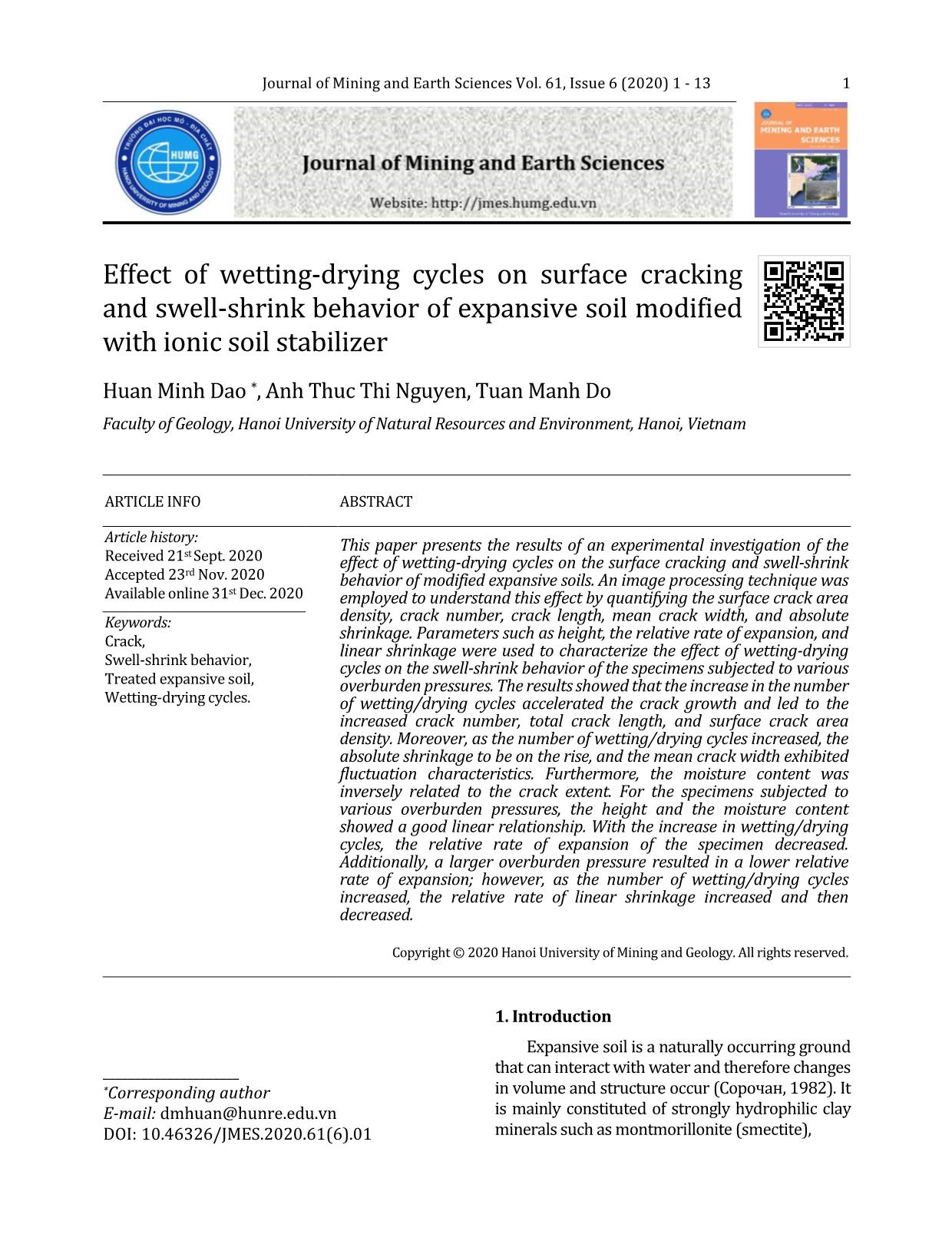
Trang 1
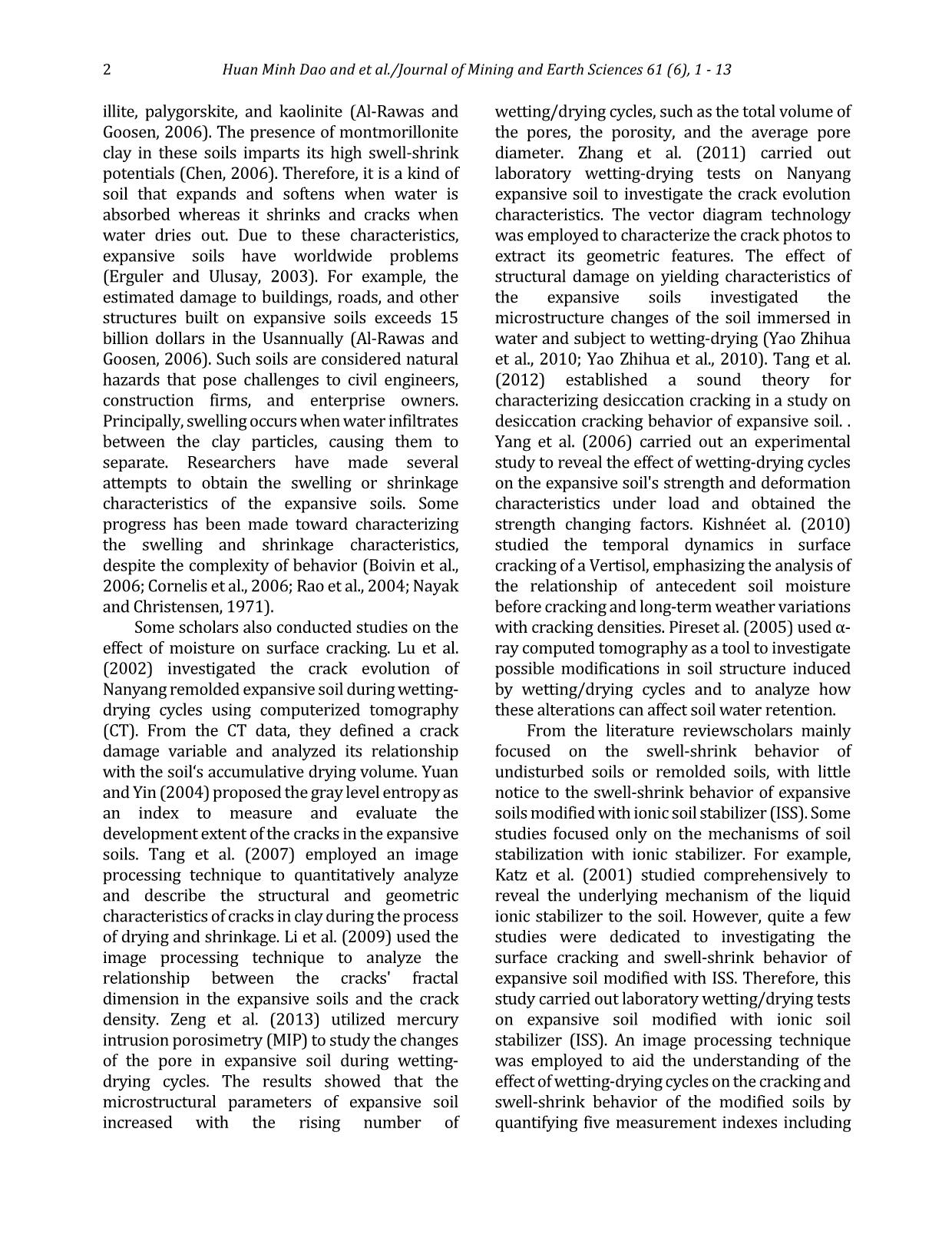
Trang 2
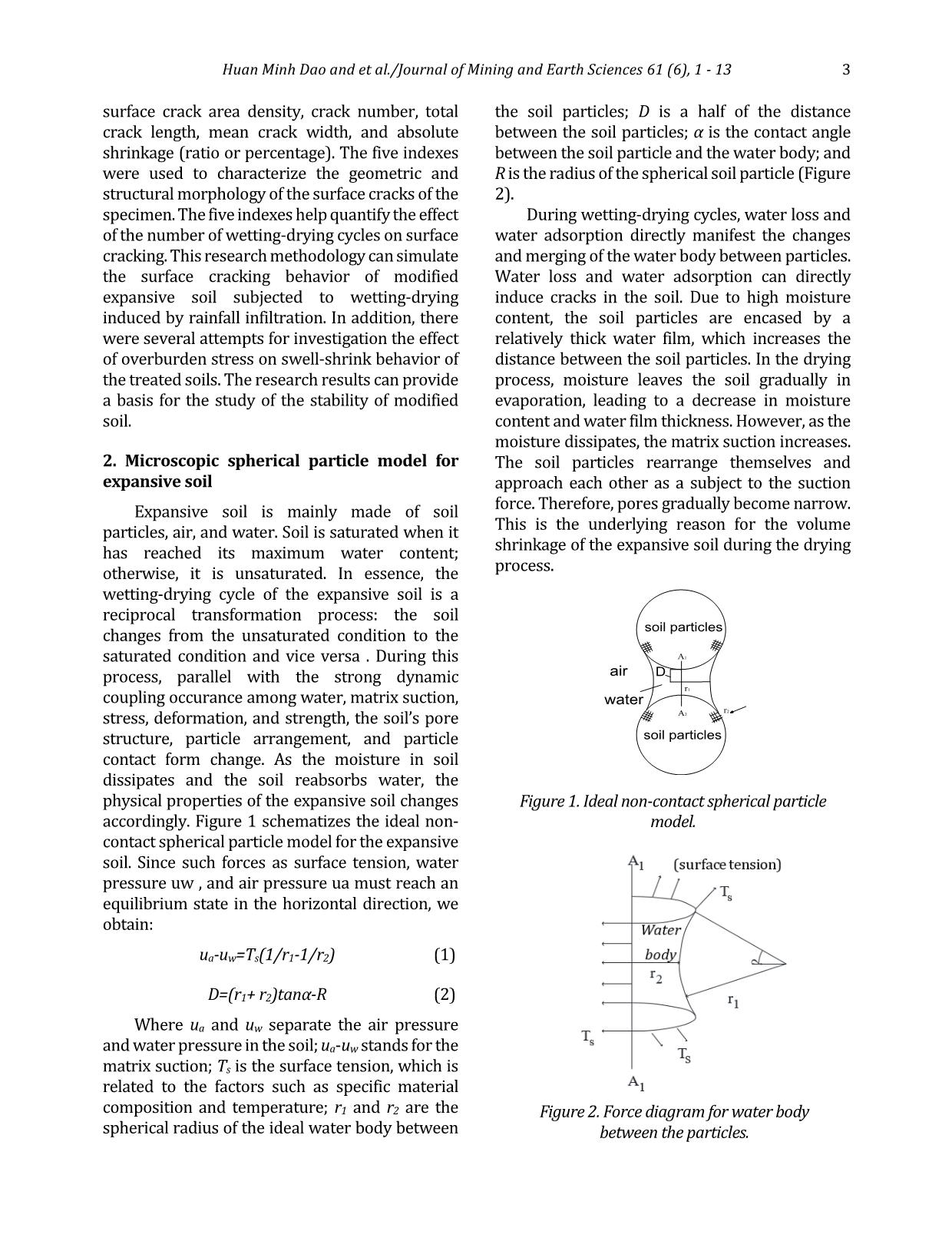
Trang 3
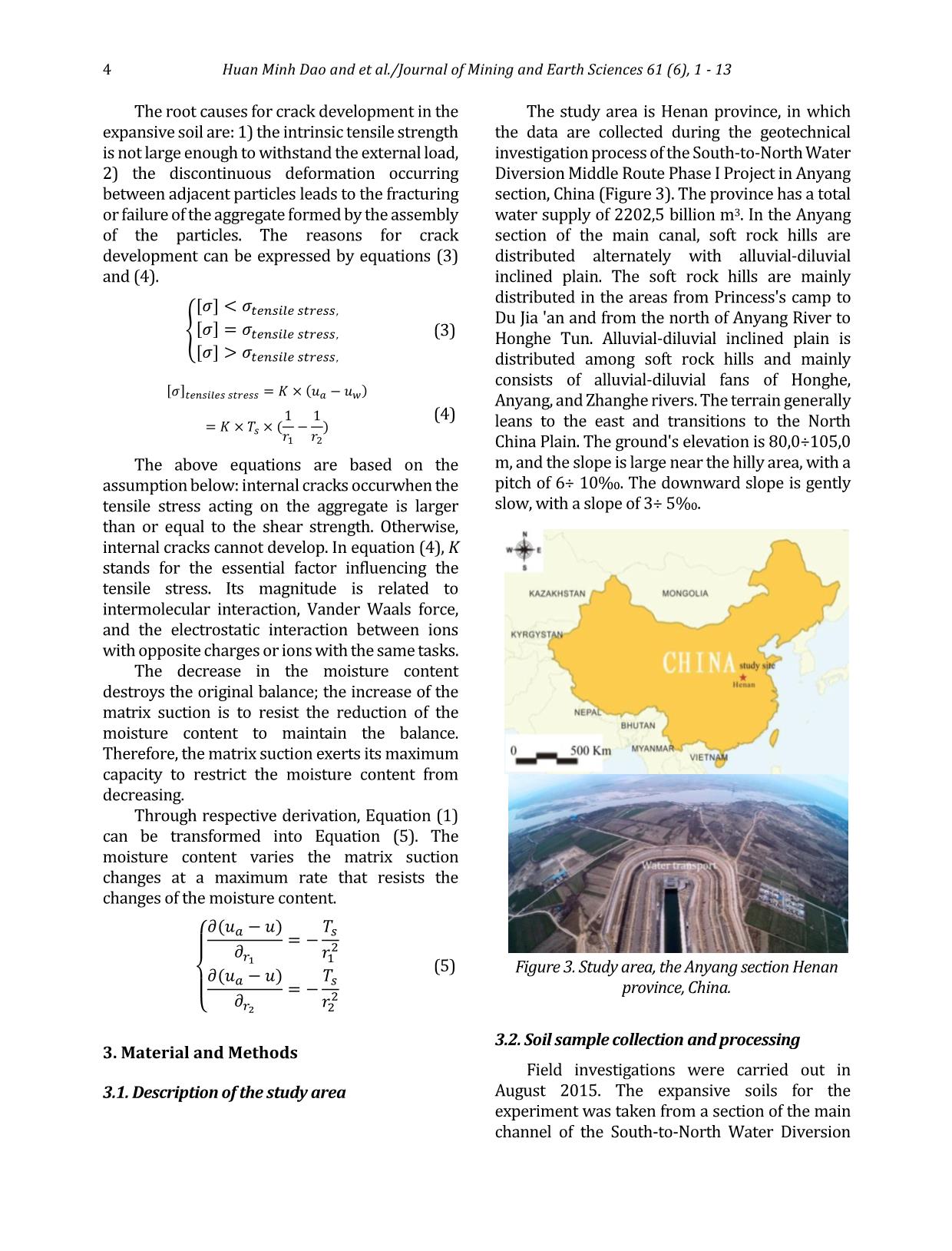
Trang 4
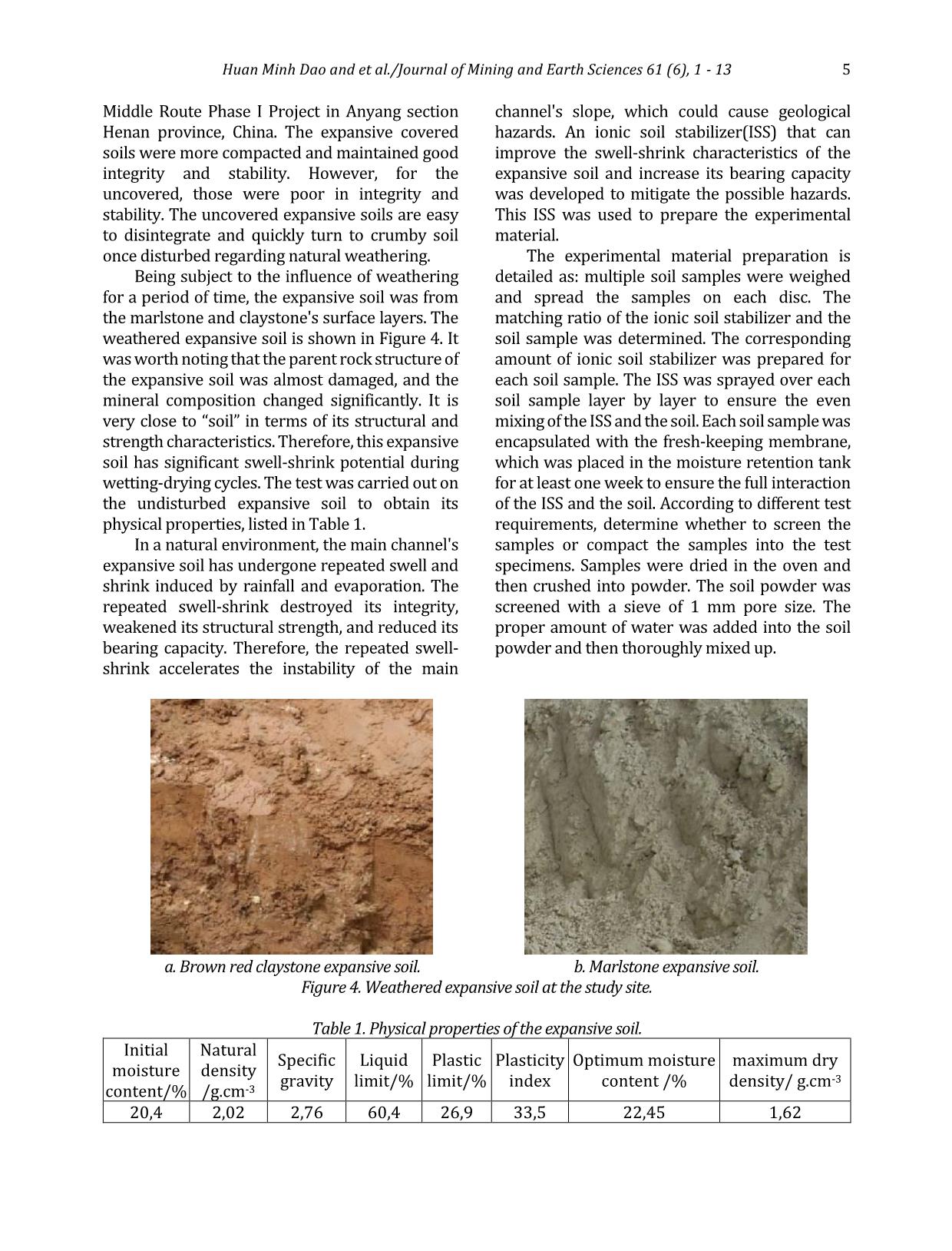
Trang 5
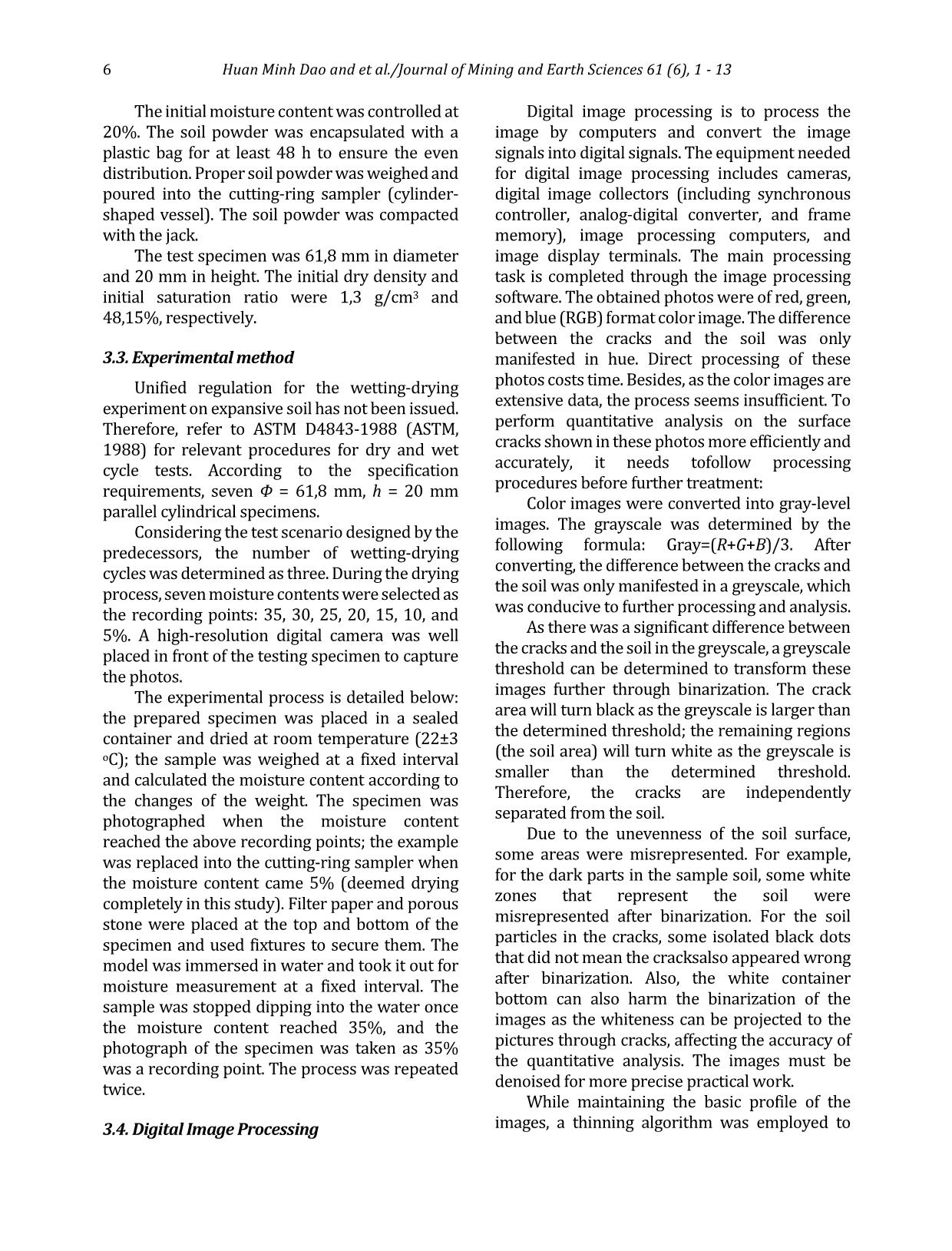
Trang 6
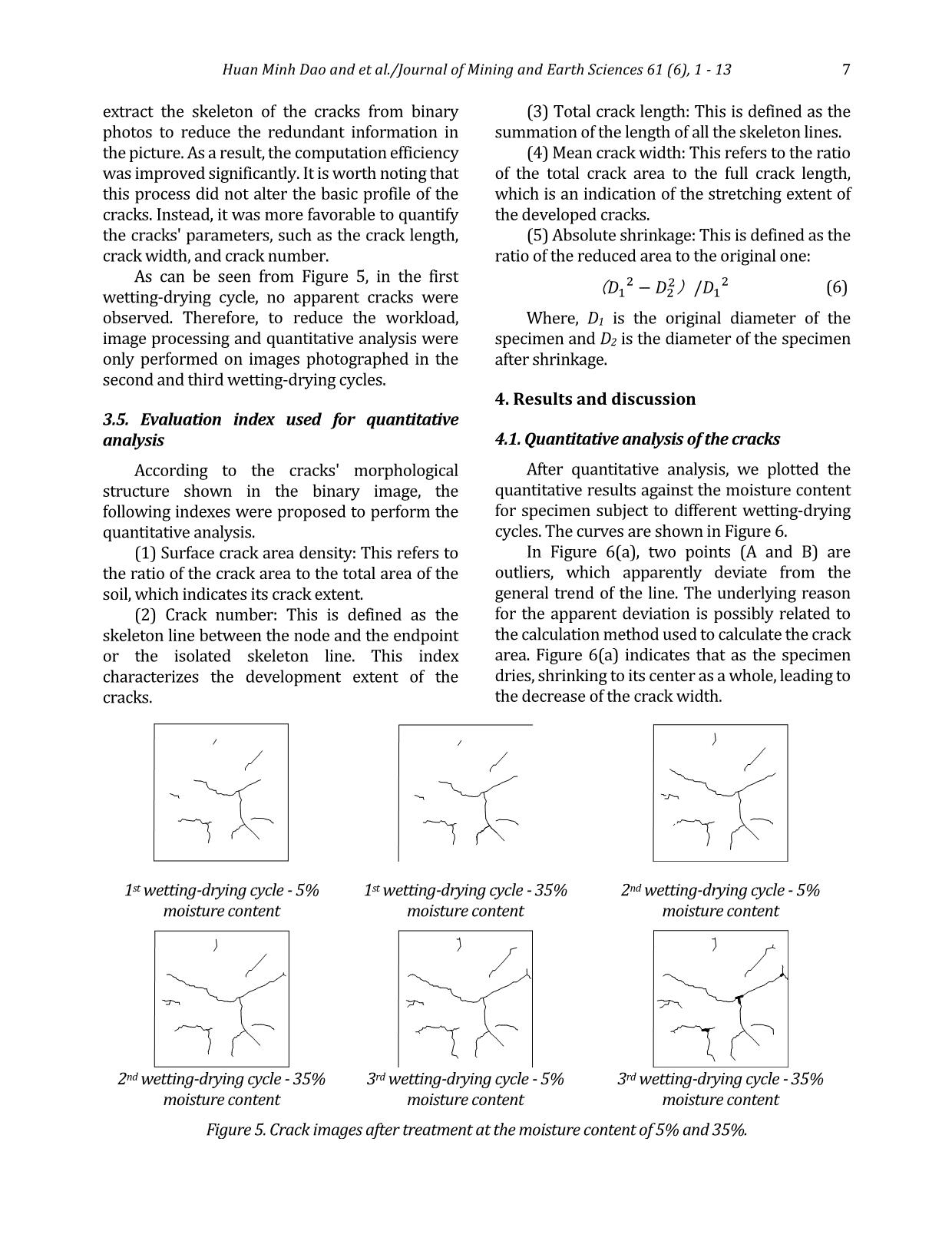
Trang 7
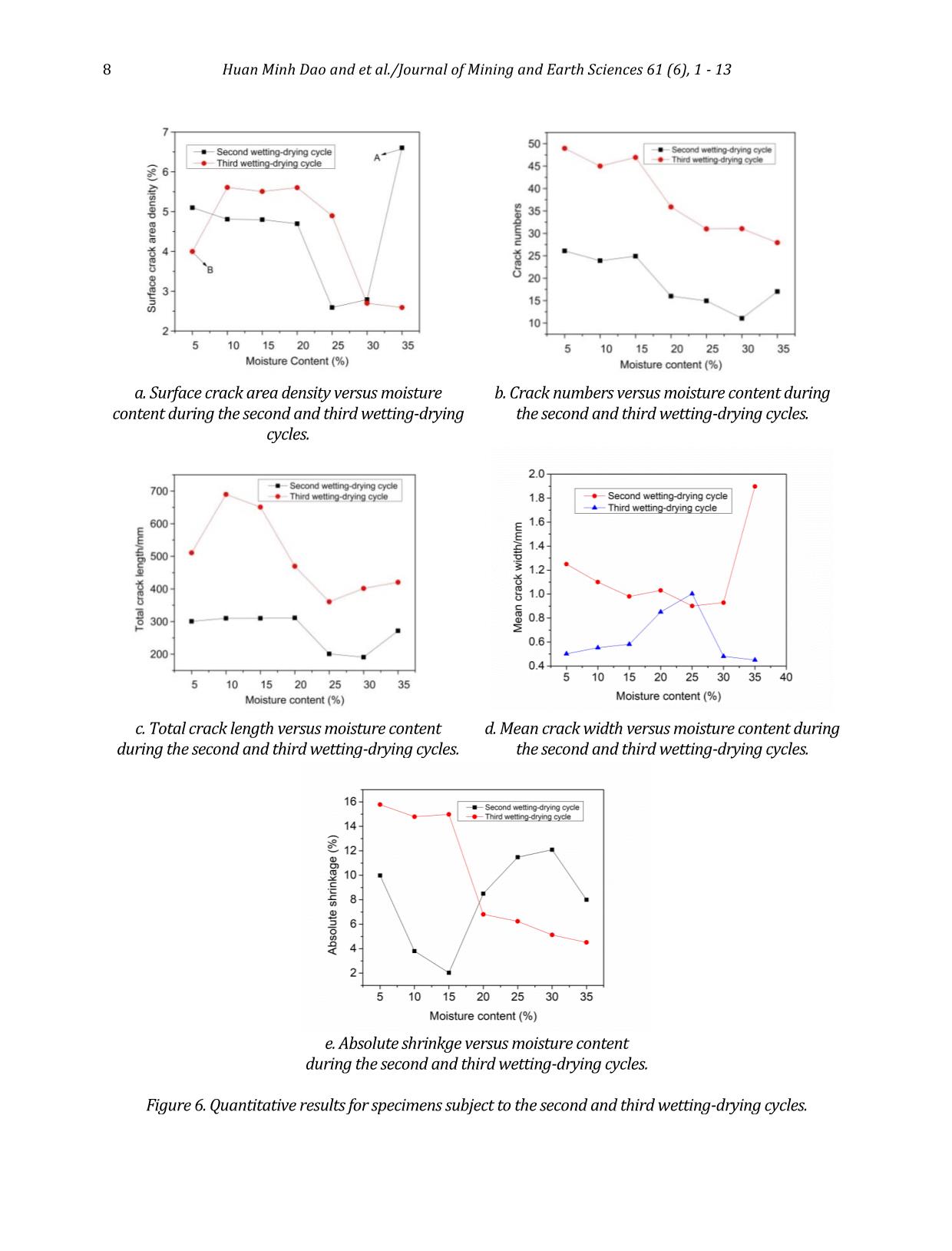
Trang 8
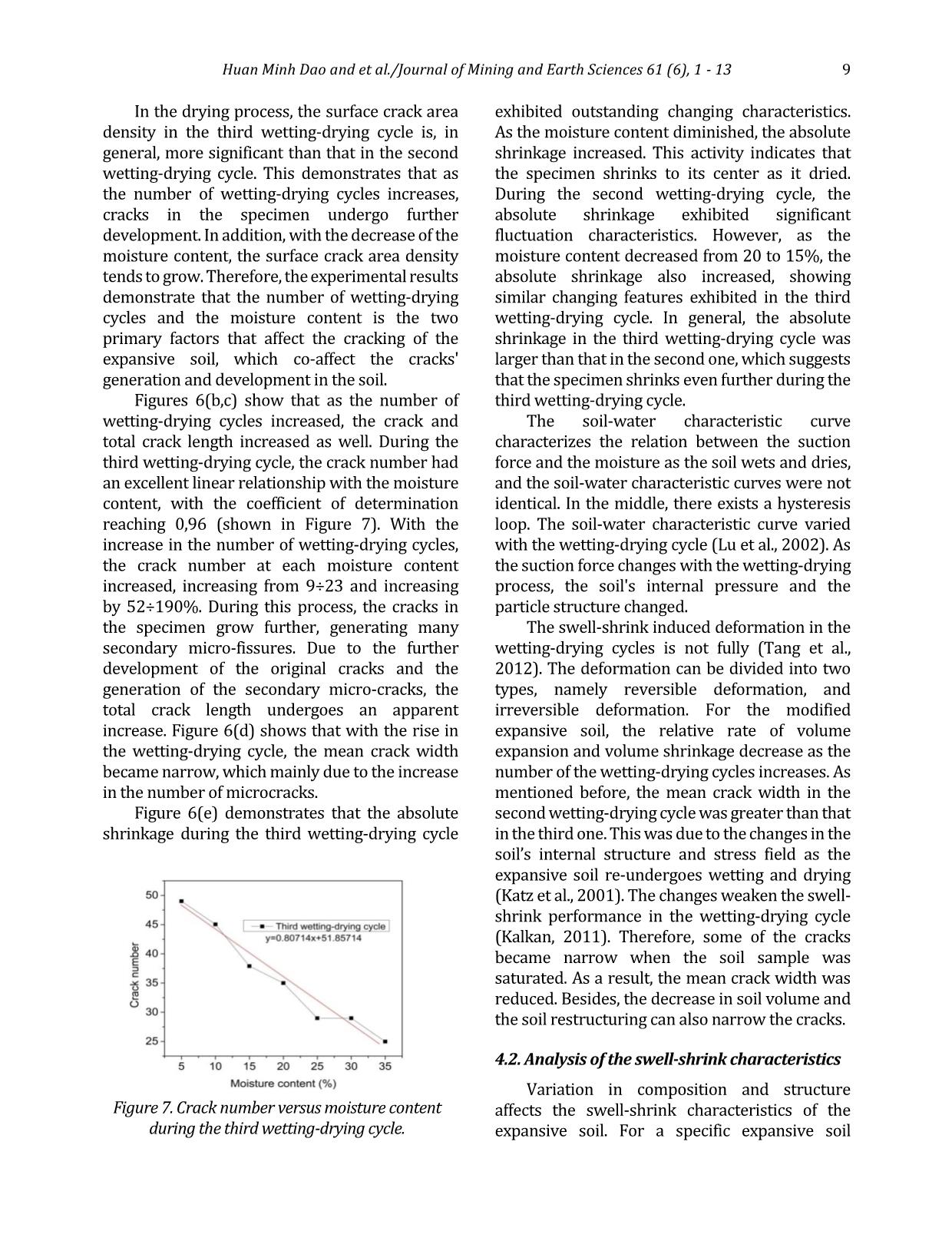
Trang 9
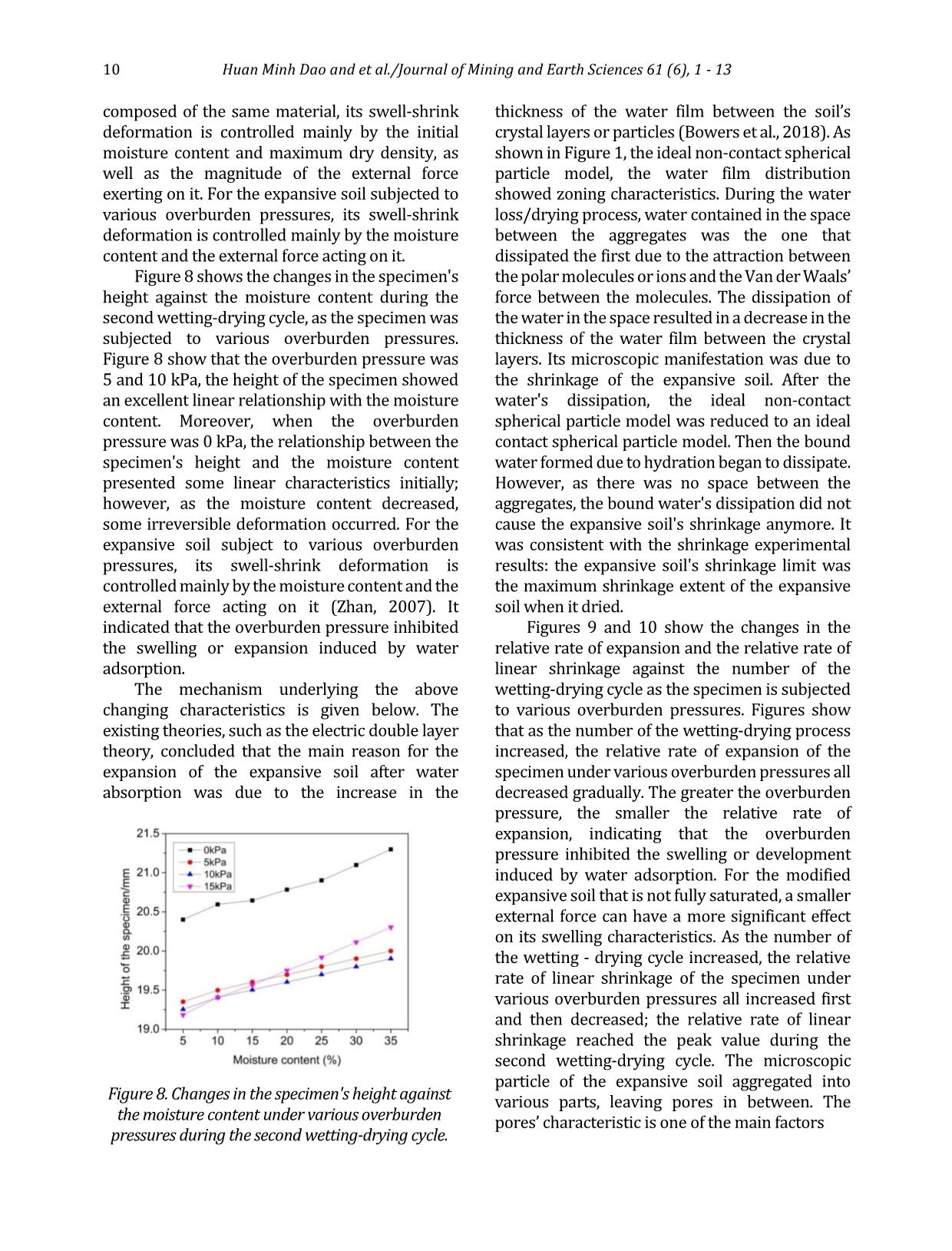
Trang 10
Tải về để xem bản đầy đủ
Tóm tắt nội dung tài liệu: Effect of wetting-Drying cycles on surface cracking and swell-shrink behavior of expansive soil modified with ionic soil stabilizer
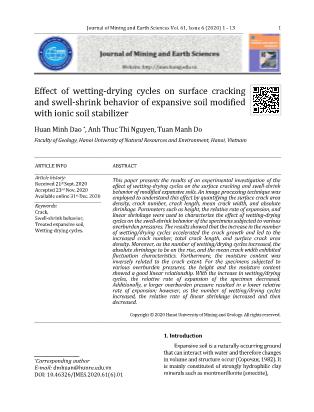
Journal of Mining and Earth Sciences Vol. 61, Issue 6 (2020) 1 - 13 1 Effect of wetting-drying cycles on surface cracking and swell-shrink behavior of expansive soil modified with ionic soil stabilizer Huan Minh Dao *, Anh Thuc Thi Nguyen, Tuan Manh Do Faculty of Geology, Hanoi University of Natural Resources and Environment, Hanoi, Vietnam ARTICLE INFO ABSTRACT Article history: Received 21st Sept. 2020 Accepted 23rd Nov. 2020 Available online 31st Dec. 2020 This paper presents the results of an experimental investigation of the effect of wetting-drying cycles on the surface cracking and swell-shrink behavior of modified expansive soils. An image processing technique was employed to understand this effect by quantifying the surface crack area density, crack number, crack length, mean crack width, and absolute shrinkage. Parameters such as height, the relative rate of expansion, and linear shrinkage were used to characterize the effect of wetting-drying cycles on the swell-shrink behavior of the specimens subjected to various overburden pressures. The results showed that the increase in the number of wetting/drying cycles accelerated the crack growth and led to the increased crack number, total crack length, and surface crack area density. Moreover, as the number of wetting/drying cycles increased, the absolute shrinkage to be on the rise, and the mean crack width exhibited fluctuation characteristics. Furthermore, the moisture content was inversely related to the crack extent. For the specimens subjected to various overburden pressures, the height and the moisture content showed a good linear relationship. With the increase in wetting/drying cycles, the relative rate of expansion of the specimen decreased. Additionally, a larger overburden pressure resulted in a lower relative rate of expansion; however, as the number of wetting/drying cycles increased, the relative rate of linear shrinkage increased and then decreased. Copyright © 2020 Hanoi University of Mining and Geology. All rights reserved. Keywords: Crack, Swell-shrink behavior, Treated expansive soil, Wetting-drying cycles. 1. Introduction Expansive soil is a naturally occurring ground that can interact with water and therefore changes in volume and structure occur (Сорочан, 1982). It is mainly constituted of strongly hydrophilic clay minerals such as montmorillonite (smectite), _____________________ *Corresponding author E-mail: dmhuan@hunre.edu.vn DOI: 10.46326/JMES.2020.61(6).01 2 Huan Minh Dao and et al./Journal of Mining and Earth Sciences 61 (6), 1 - 13 illite, palygorskite, and kaolinite (Al-Rawas and Goosen, 2006). The presence of montmorillonite clay in these soils imparts its high swell-shrink potentials (Chen, 2006). Therefore, it is a kind of soil that expands and softens when water is absorbed whereas it shrinks and cracks when water dries out. Due to these characteristics, expansive soils have worldwide problems (Erguler and Ulusay, 2003). For example, the estimated damage to buildings, roads, and other structures built on expansive soils exceeds 15 billion dollars in the Usannually (Al-Rawas and Goosen, 2006). Such soils are considered natural hazards that pose challenges to civil engineers, construction firms, and enterprise owners. Principally, swelling occurs when water infiltrates between the clay particles, causing them to separate. Researchers have made several attempts to obtain the swelling or shrinkage characteristics of the expansive soils. Some progress has been made toward characterizing the swelling and shrinkage characteristics, despite the complexity of behavior (Boivin et al., 2006; Cornelis et al., 2006; Rao et al., 2004; Nayak and Christensen, 1971). Some scholars also conducted studies on the effect of moisture on surface cracking. Lu et al. (2002) investigated the crack evolution of Nanyang remolded expansive soil during wetting- drying cycles using computerized tomography (CT). From the CT data, they defined a crack damage variable and analyzed its relationship with the soil‘s accumulative drying volume. Yuan and Yin (2004) proposed the gray level entropy as an index to measure and evaluate the development extent of the cracks in the expansive soils. Tang et al. (2007) employed an image processing technique to quantitatively analyze and describe the structural and geometric characteristics of cracks in clay during the process of drying and shrinkage. Li et al. (2009) used the image processing technique to analyze the relationship between the cracks' fractal dimension in the expansive soils and the crack density. Zeng et al. (2013) utilized mercury intrusion porosimetry (MIP) to study the changes of the pore in expansive soil during wetting- drying cycles. The results showed that the microstructural parameters of expansive soil increased with the rising number of wetting/drying cycles, such as the total volume of the pores, the porosity, and the average pore diameter. Zhang et al. (2011) carried out laboratory wetting-drying tests on Nanyang expansive soil to investigate the crack evolution characteristics. The vector diagram technology was employed to characterize the crack photos to extract its geometric features. The effect of structural damage on yielding characteristics of the expansive soils investigated the microstructure changes of the soil immersed in water and subject to wetting-drying (Yao Zhihua et al., 2010; Yao Zhihua et al., 2010). Tang et al. (2012) established a sound theory for characterizing desiccation cracking in a study on desiccation cracking behavior of expansive soil. . Yang et al. (2006) carried out an experimental study to reveal the effect of wetting-drying cycles on the expansive soil's strength and deformation characteristics under ... men showed an excellent linear relationship with the moisture content. Moreover, when the overburden pressure was 0 kPa, the relationship between the specimen's height and the moisture content presented some linear characteristics initially; however, as the moisture content decreased, some irreversible deformation occurred. For the expansive soil subject to various overburden pressures, its swell-shrink deformation is controlled mainly by the moisture content and the external force acting on it (Zhan, 2007). It indicated that the overburden pressure inhibited the swelling or expansion induced by water adsorption. The mechanism underlying the above changing characteristics is given below. The existing theories, such as the electric double layer theory, concluded that the main reason for the expansion of the expansive soil after water absorption was due to the increase in the thickness of the water film between the soil’s crystal layers or particles (Bowers et al., 2018). As shown in Figure 1, the ideal non-contact spherical particle model, the water film distribution showed zoning characteristics. During the water loss/drying process, water contained in the space between the aggregates was the one that dissipated the first due to the attraction between the polar molecules or ions and the Van der Waals’ force between the molecules. The dissipation of the water in the space resulted in a decrease in the thickness of the water film between the crystal layers. Its microscopic manifestation was due to the shrinkage of the expansive soil. After the water's dissipation, the ideal non-contact spherical particle model was reduced to an ideal contact spherical particle model. Then the bound water formed due to hydration began to dissipate. However, as there was no space between the aggregates, the bound water's dissipation did not cause the expansive soil's shrinkage anymore. It was consistent with the shrinkage experimental results: the expansive soil's shrinkage limit was the maximum shrinkage extent of the expansive soil when it dried. Figures 9 and 10 show the changes in the relative rate of expansion and the relative rate of linear shrinkage against the number of the wetting-drying cycle as the specimen is subjected to various overburden pressures. Figures show that as the number of the wetting-drying process increased, the relative rate of expansion of the specimen under various overburden pressures all decreased gradually. The greater the overburden pressure, the smaller the relative rate of expansion, indicating that the overburden pressure inhibited the swelling or development induced by water adsorption. For the modified expansive soil that is not fully saturated, a smaller external force can have a more significant effect on its swelling characteristics. As the number of the wetting - drying cycle increased, the relative rate of linear shrinkage of the specimen under various overburden pressures all increased first and then decreased; the relative rate of linear shrinkage reached the peak value during the second wetting-drying cycle. The microscopic particle of the expansive soil aggregated into various parts, leaving pores in between. The pores’ characteristic is one of the main factors Figure 8. Changes in the specimen's height against the moisture content under various overburden pressures during the second wetting-drying cycle. Huan Minh Dao and et al./Journal of Mining and Earth Sciences 61 (6), 1 - 13 11 that determine how the expansive soil behaves during shrinking and swelling (Hai-bo et al., 2009). As the soil absorbs water the first time, it expands, and the pores between the aggregates are filled by water. In the meantime, water film increases in thickness, resulting in the further swelling/expansion of the soil. Also, changes take place in the structural form between the aggregates. The aggregates can expand and undergo self-rotation due to the unbalanced force induced by water adsorption. As a result, the pore ratio of the expansive soil grows. During the water loss (drying) process, the free water contained in the space between the aggregates is the one that dissipates first, while in the meantime, tensile cracks begin to develop inside the soil. In the first wetting-drying cycle, the generated tensile cracks did not play a prominent role in swell-shrink deformation (Tang et al., 2016). However, a significant role was played in the second wetting- drying cycle as the generated tensile cracks coalesce and grow, destroying the soil’s integral structure, causing a significant number of micro- cracks inside the aggregates. As a result, the strength of the soil decreases materially. This is further compounded by the overburden pressure, which results in the collapse of the aggregates. Therefore, in the second wetting-drying cycle, the swell-shrink deformation also involves the deformation induced by the aggregates' collapse. It explains the relative rate of linear shrinkage reaches the peak value in the second wetting- drying cycle, and it reduces as the number of the wetting-drying cycle increases. 5. Conclusions (1) The number of wetting-drying cycles affects the development of cracks in the modified expansive soil. As the number of the wetting- drying cycle increases, cracks develop profusely. In comparison with the second wetting-drying cycle, in the third wetting-drying cycle, the surface crack area density increases by 1%, the crack number grows by 99%, the total crack length increases by 85%, the absolute shrinkage grows by 85%, and the mean crack width expands by 83%. (2) During the drying of the modified expansive soil, the moisture content, in general, is inversely related to the crack extent. As the moisture content decreases, parameters like surface crack area density, crack number, total crack length, and absolute shrinkage increasing by 8%, 11%, 5%, and 30%, respectively, at each moisture content recoding point. However, the mean crack width, it changes irregularly as the overall swell-shrink of the specimen causes significant changes in the crack width. (3) The modified expansive soil is over- consolidated and shows significant swell-shrink characteristics in the wetting-drying cycle. Cracks are easy to develop in the modified expansive soil. Also, it is a collapsible soil. Under high moisture Figure 9. Changes in the relative rate of expansion against the number of the wetting-drying cycle as the specimen being subject to various overburden pressures. Figure 10. Changes in the relative rate of linear shrinkage against the number of the wetting- drying cycle as the specimen being subject to various overburden pressures. 12 Huan Minh Dao and et al./Journal of Mining and Earth Sciences 61 (6), 1 - 13 content, under the overburden pressure, crack in the expansive soil closes and the soil undergoes significant restructuring. As the number of the wetting-drying cycle increases, the height of the specimen decreases. In comparison with the 5% moisture content recording point at various overburden pressures, the specimen’s height on average increases by about 1 mm at the 35% moisture content recording point. (4) The overburden pressure has an inhibition effect on the modified expansive soil's swell-shrink characteristics. As the number of the wetting-drying cycle increases, more and more cracks develop in the expansive soil, which is accompanied by the occurrence of apparent macroscopic cracks and plane of failure and the material increase of the pore ratio. Compared with the first wetting-drying cycle, the relative rate of expansion in the third wetting-drying cycle reduces by 41%. The repeated wetting-drying cycle has destroyed the specimen's internal structure, causing many cracks. When the moisture content reaches a certain level, and the overburden pressure is significant enough, the expansive soil would also undergo collapsible deformation after repeated wetting-drying. Acknowledgment This research did not receive any specific grant from funding agencies in the public, commercial, or not for profit sectors. The author would like many thanks to Dr. Nguyen Thi Thuc Anh and Do Manh Tuan for English editing and comments. All these contributions have helped a lot to improve the quality of the paper. Conflict of interest All authors declare no conflict of interest. References Al-Rawas, A. A., Goosen, M. F., (2006). Expansive soils: recent advances in characterization and treatment. Taylor & Francis. American Society for Testing and Materials, ASTM D4843-1988, (1988). Standard test method for wetting and drying test of solid wastes[S]. Philadephta: ASTM Press. Boivin, P., Garnier, P.,Vauclin, M., (2006). Modeling the soil shrinkage and water retention curves with the same equations. Soil science society of America journal 70(4), 1082- 1093. Bowers, G. M., Loring, J. S., Schaef, H. T., Walter, E. D., Burton, S. D., Hoyt, D. W., Kirkpatrick, R. J., (2018). Interaction of Hydrocarbons with Clays under Reservoir Conditions: In Situ Infrared and Nuclear Magnetic Resonance Spectroscopy and X-ray Diffraction for Expandable Clays with Variably Wet Supercritical Methane. ACS Earth and Space Chemistry. Chen, F. H., (2006). Foundations on expansive soils (Vol. 12). Elsevier. Cornelis, W. M., Corluy, J., Medina, H., Diaz, J., Hartmann, R., Van Meirvenne, M., Ruiz, M. E., (2006). Measuring and modelling the soil shrinkage characteristic curve. Geoderma 137(1-2), 179-191. Erguler, Z. A., Ulusay, R., (2003). A simple test and predictive models for assessing swell potential of Ankara (Turkey) Clay. Engineering Geology 67(3-4), 331-352. Hai-bo, Lu., Zhao-tian, Zeng., Yan-lin, Zhao., Hao, L., (2009). Experimental studies of strength of expansive soil in drying and wetting cycle. Rock and Soil Mechanics 30(12), 3797-3802. Kalkan, E., (2011). Impact of wetting-drying cycles on swelling behavior of clayey soils modified by silica fume. Applied Clay Science 52(4), 345- 352. Katz, L. E., Rauch, A. F., Liljestrand, H. M., Harmon, J. S., Shaw, K. S., & Albers, H., (2001). Mechanisms of soil stabilization with liquid ionic stabilizer. Transportation Research Record 1757(1), 50-57. Kishné, A. S., Morgan, C. L., Ge, Y., Miller, W. L., (2010). Antecedent soil moisture affecting surface cracking of a Vertisol in field conditions. Geoderma 157(3-4), 109-117. Li, X. W., Feng, X., & Zhang, Y., (2009). Depicting and analysis of expansive soil fissure in view of plane. Hydrogeology and Engineering Geology 1, 96-99. Huan Minh Dao and et al./Journal of Mining and Earth Sciences 61 (6), 1 - 13 13 Lu, Z. H., Chen, Z. H., Pu, Y. B., (2002). A CT study on the crack evolution of expansive soil during drying and wetting cycles. Rock and Soil Mechanics-Wuhan 23(4; ISSU 78), 417-422. Nayak, N. V., Christensen, R. W., (1971). Swelling characteristics of compacted expansive soils. Clays and Clay Minerals 19(4), 251 - 261. Pires, L. F., Bacchi, O. O., Reichardt, K., (2005). Gamma ray computed tomography to evaluate wetting/drying soil structure changes. Nuclear instruments and methods in physics research section B: beam interactions with materials and atoms 229(3-4), 443-456. Rao, A. S., Phanikumar, B. R., Sharma, R. S., (2004). Prediction of swelling characteristics of remoulded and compacted expansive soils using free swell index. Quarterly Journal of Engineering Geology and Hydrogeology 37(3), 217-226. Tang, C. H., Shi, B., Liu, C., (2012). Study on desiccation cracking behavior of expansive soil. Journal of Engineering Geology 20(5), 663- 673. Tang, C. S., Shi, B., Liu, C., Wang, B. J., (2007). Factors affecting the surface cracking in clay due to drying shrinkage. Journal of Hydraulic Engineering 10. Tang, C. S., Wang, D. Y., Shi, B., Li, J., (2016). Effect of wetting-drying cycles on profile mechanical behavior of soils with different initial conditions. Catena 139, 105-116. Yang, H. P., Zhang, R., Zheng, J. L., (2006). Variation of deformation and strength of expansive soil during cyclic wetting and drying under loading condition. Yantu Gongcheng Xuebao (Chinese Journal of Geotechnical Engineering) 28(11), 1936-1941. Yao Zhihua, Chen Zhenghan, Huang Xuefeng, et al., (2010). Influence of structural damage on yielding characteristics of expansive soils [J]. Chinese Journal of Rock Mechanics and Engineering 29(7), 1503-1512. Yao Zhihua., Chen Zhenghan., Zhu Yuan-qing., Shiji, W., (2010). Meso-structural change of remolded expansive soils during wetting- drying cycles and triaxial soaking tests. Chinese Journal of Geotechnical Engineering 32(1), 68- 76. Yuan, J. P., Yin, Z. Z., (2004). Quantitative index of fissure and strength characteristics of fissured expansive soils [J]. Journal of Hydraulic Engineering 6, 108-113. Zeng, Z. T., Lu, H. B., Zhao, Y. L., Wang, Z. B., (2013). Study of pore size distribution of expansive soil during wetting-drying cycle and its application. Rock and Soil Mechanics 34(2), 322-328. Zhan, L., (2007). Soil-water interaction in unsaturated expansive soil slopes. Frontiers of Architecture and Civil Engineering in China 1(2), 198. Zhang, J. J., Gong, B. W., Hu, B., Zhou, X. W., Wang, J., (2011). Study of evolution law of fissures of expansive clay under wetting and drying cycles. Rock and Soil Mechanics 32(9), 2729- 2734. Сорочан. E. A, (1982). Design and construction of buildings on expansive soil [M]. Beijing. China Building Industry Press.
File đính kèm:
 effect_of_wetting_drying_cycles_on_surface_cracking_and_swel.pdf
effect_of_wetting_drying_cycles_on_surface_cracking_and_swel.pdf

